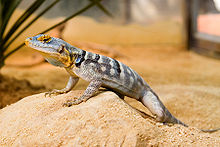California rock lizard
This article needs additional citations for verification. (December 2009) |
| California rock lizards - Petrosaurus | |
|---|---|

| |
| Baja blue rock lizard | |
| Scientific classification | |
| Kingdom: | Animalia |
| Phylum: | Chordata |
| Class: | Reptilia |
| Order: | Squamata |
| Suborder: | Iguania |
| Family: | Phrynosomatidae |
| Genus: | Petrosaurus Boulenger, 1885[1] |
| Species | |
|
See text | |
The California rock lizards are a genus (Petrosaurus) of New World lizards in the family Phrynosomatidae.[2]
Geographic range[]
They are endemic to southern California and Baja California, Mexico.[3]
Habitat[]
This lizard species lives almost exclusively on rock outcrops, boulder piles, and canyon walls, where it shelters under rocks. Their habitat consists of arid and semiarid foothills and canyons along the western margin of the Colorado Desert.[4]
Reproduction[]
The courtship begins shortly after emergence in early spring. The eggs are laid around June and July.
Predators[]
The few predators that could pursue this lizard are collared lizards and avian predators, such as hawks, ravens, and roadrunners.
Species[]
The genus Petrosaurus contains three species.
- Petrosaurus mearnsi (Stejneger, 1894) - banded rock lizard
- (Van Denburgh, 1895)
- Petrosaurus thalassinus (Cope, 1863) - Baja blue rock lizard[5]
References[]
- ^ Dahms Tierleben. www.dahmstierleben.de.
- ^ Smith, H.M. and E.D. Brodie, Jr. 1982. Reptiles of North America, A Guide to Field Identification. Golden Press. New York. pp. 110-111.
- ^ Stejneger, Leonhard and Thomas Barbour. 1917. A Check List of North American Amphibians and Reptiles. Harvard University Press. Cambridge, Massachusetts. pp. 50-52.
- ^ http://www.socalcamping.com/fieldguide/reptile/bandedrocklizard.html
- ^ The Reptile Database. www.reptile-database.org.
Categories:
- Phrynosomatidae
- Fauna of the California chaparral and woodlands
- Fauna of the Mojave Desert
- Taxa named by George Albert Boulenger
- Lizard stubs